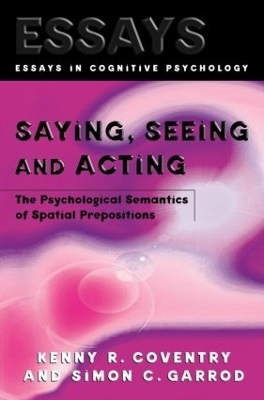
Saying, Seeing and Acting
Psychology Press Ltd (Verlag)
978-1-84169-116-9 (ISBN)
Our use of spatial prepositions carries an implicit understanding of the functional relationships both between objects themselves and human interaction with those objects.
This is the thesis rigorously explicated in Saying, Seeing and Acting. It aims to account not only for our theoretical comprehension of spatial relations but our ability to intercede with efficacy in the world of spatially related objects. Only the phenomenon of functionality can adequately account for what even the simplest of everyday experiences show to be the technically problematic, but still meaningful status of expressions of spatial location in contentious cases.
The terms of the debate are established and contextualised in Part One. In the Second Section, systematic experimental evidence is drawn upon to demonstrate specific covariances between spatial world and spatial language. The authors go on to give an original account of the functional and geometric constraints on which comprehension and human action among spatially related objects is based. Part Three looks at the interaction of these constraints to create a truly dynamic functional geometric framework for the meaningful use of spatial prepositions.
Fascinating to anyone whose work touches on psycholinguistics, this book represents a thorough and incisive contribution to debates in the cognitive psychology of language.
Kenny R. Coventry is the Reader in Cognitive Science at the University of Plymouth. He co-ordinates the Spatial Language Group, and is a member of the Centre for Thinking and Language. Simon C. Garrod is a Professor in Psychology at the University of Glasgow. He holds the Chair in Cognitive Psychology and is Director of the Human Communication Research Centre project in Glasgow.
Part 1: Saying, Seeing and Acting. Background to the Domain. Introduction to the Domain. Saying Spatial Prepositions and Lexical Semantics. Grounding Language in Perception - From "Saying" to "Seeing and Acting". Part 2: Saying, Seeing and Acting: Constructing an Account. Introducing the Functional Geometric Framework. Experimental Evidence for the Functional Geometric Framework. The So-called Topographical Prepositions. Experimental Evidence for the Functional Geometric Framework. Which Way up is up? The Projective Prepositions. Experimental Evidence for the Functional Geometric Framework. Other Prepositions: Proximity, Coincidence and Being between. Part 3: Putting Saying, Seeing and Acting Together. The Functional Geometric Framework in Action. Putting It all Together. Cross-linguistic and Developmental Implications. Extensions, Links and Conclusions. References.
| Reihe/Serie | Essays in Cognitive Psychology |
|---|---|
| Verlagsort | Hove |
| Sprache | englisch |
| Maße | 156 x 234 mm |
| Gewicht | 560 g |
| Themenwelt | Schulbuch / Wörterbuch ► Wörterbuch / Fremdsprachen |
| Geisteswissenschaften ► Psychologie ► Allgemeine Psychologie | |
| Geisteswissenschaften ► Psychologie ► Verhaltenstherapie | |
| Geisteswissenschaften ► Sprach- / Literaturwissenschaft ► Anglistik / Amerikanistik | |
| Geisteswissenschaften ► Sprach- / Literaturwissenschaft ► Sprachwissenschaft | |
| ISBN-10 | 1-84169-116-X / 184169116X |
| ISBN-13 | 978-1-84169-116-9 / 9781841691169 |
| Zustand | Neuware |
| Informationen gemäß Produktsicherheitsverordnung (GPSR) | |
| Haben Sie eine Frage zum Produkt? |
aus dem Bereich


